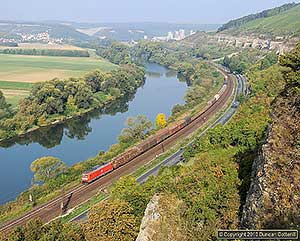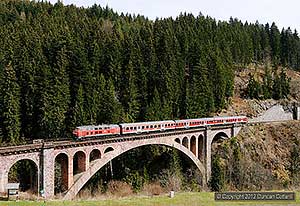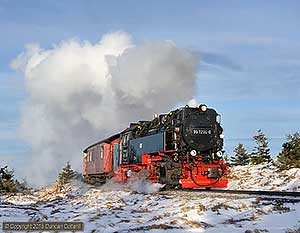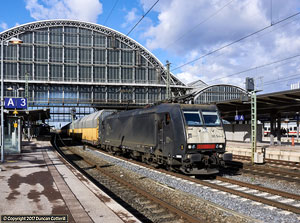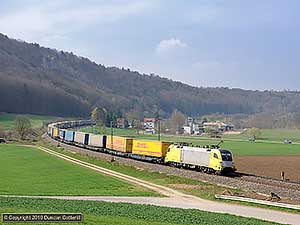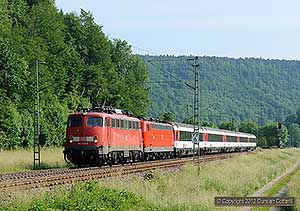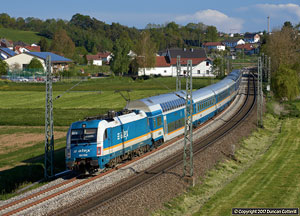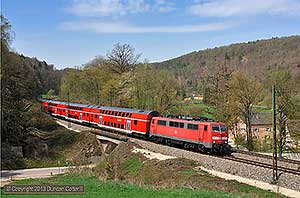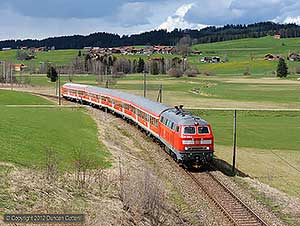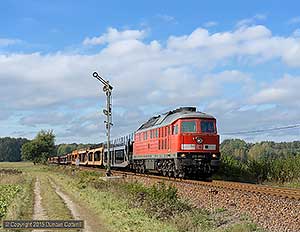140 Hamburg - Lübeck - Kiel
7 photos
updated : 2022-12-03
The highlight of the Hamburg - Lübeck - Kiel route is the magnificent Lübeck Hbf with its fine overall roof. In the early 1980s the south end of the station was still semaphore signalled and the area was the last stamping ground of the stylish Class 220 diesel-hydraulics. Electrification came in 2008.
970 München - Lindau / Oberstdorf
290 photos
updated : 2022-09-04
The Allgäubahn is one of Germany's most photogenic lines, running through the rolling hills of southern Bayern and skirting the Alps along the Austrian border. It's lost its importance as a through route in recent years but still saw a lot of loco hauled passenger trains until recently.
940 Mühldorf Area
68 photos
updated : 2022-09-01
Mühldorf lies at the centre of a group of diesel worked lines east of München. There are locos on a few passengers but most are DMUs. The big attractions were freight traffic and semaphore signals. In late 2010 Class 266s ousted most of the interesting locos and many of the semaphores were replaced.
870 Hersbruck - Schwandorf / Weiden
55 photos
updated : 2022-09-01
The lines from Hersbruck to Weiden and Schwandorf are diesel worked routes running through the attractive hilly country north and east of Nürnberg. All passengers are DMUs these days but there were some loco hauled trains until 2012 and a number of freights hauled by ex-DR class 232 locos.
855 Regensburg - Marktredwitz
31 photos
updated : 2022-08-31
This was the Berlin - München main line before WWII but is now a quiet double track unelectrified route running through the very attractive and sparsely populated countryside of north-eastern Bayern. There are still regular loco hauled passengers and a few freights, some hauled by Class 232s.
800 Aschaffenburg - Würzburg
39 photos
updated : 2022-08-31
The valley of the River Main provides a route for traffic from Frankfurt and north Germany into Bavaria. Freight traffic is heavy, the scenery is attractive and the passenger trains used to be loco hauled. Most of DB's electric classes could be seen at work along with locos belonging to open-access operators.
755 Ulm - Neustadt(Schwarzw)
1 photo
updated : 2022-08-31
This long rural east - west route across southern Germany is a bit of a backwater. The line is pleasantly scenic in places but the service has been sparse and entirely DMU operated in recent years apart from a weekends only bike train with a 218. The line west of Donaueschingen was electrified in 2019.
751 Ulm - Friedrichshafen
32 photos
updated : 2022-08-31
The Südbahn runs south from Ulm to Friedrichshafen via Biberach and Ravensburg and is double track. Before the line was electrified there were plenty of Class 218 diesels on passengers and the occasional 232 or 294 on freight. The scenery isn’t spectacular but there were some very nice photo positions.
750 Stuttgart - Ulm
36 photos
updated : 2022-08-30
The Stuttgart - Ulm route is a busy, scenic, double-track electrified main line linking the Rhein-Main conurbation and Stuttgart with München, Austria and beyond. Like many German main lines it carries a wide variety of passenger and freight traffic worked by many different classes.
742 Villingen - Rottweil
3 photos
updated : 2022-08-30
The Villingen - Rottweil line is a 27km single-track link between the Offenburg - Singen Schwarzwaldbahn and the Stuttgart - Singen Gäubahn, via the towns of Schwenningen and Trossingen. It used to have regular semi-fast trains, a couple of which were loco hauled at weekends, but just has stoppers now.
610 Bebra - Fulda
25 photos
updated : 2022-08-29
The Bebra - Fulda line runs along Haunetal, a beautiful river valley flanked by rounded, forested hills and dotted with small farming villages. The railway is a double track electrified main line and a vital north-south link. Freight traffic is heavy and varied and there were regular loco hauled passengers until 2006.
471 Koblenz - Mainz
27 photos
updated : 2022-08-28
The electrified Koblenz - Mainz main line along the left/west bank of the Rhein was historically one of the main north-south passenger routes. It's still busy and sees more freights than in the past. Add some superb scenery and a few mediaeval towns and the photographic potential becomes obvious.
325 Harz NG Lines
76 photos
updated : 2022-08-27
The Harzer Schmalspurbahnen operate a 140km network of metre gauge lines in the Harz Mountains including a branch to the 1142m summit of the Brocken. A good proportion of trains are still worked by a fleet of 2-10-2 tank engines and the line retains a lot of the character it had when it was part of the DR system.
136 Niebüll - Dagebüll Mole
2 photos
updated : 2022-08-27
The 31km line from Niebüll to Dagebüll Mole is owned and operated by NEG, Norddeutsche Eisenbahn Gesellschaft. Passenger services are all DMUs but, unusually, some trains convey 2-coach portions of DB InterCity trains coupled behind the unit. There is no regular freight traffic.
126 Bremen Area
6 photos
updated : 2022-08-25
Bremen is a major commercial, industrial and port city and a busy rail centre. The city's main station, Bremen Hbf, is quite photogenic with frequent freights running through, underneath a fine overall roof. Passenger services are a mixture of loco hauled and units, with a couple of independent operators providing variety.
360 Hannover Area
31 photos
updated : 2017-05-29
Hannover is an important city in northern Germany with its own suburban system. It's a major railway centre where routes from all directions converge, most with heavy passenger and freight traffic. What the area lacks in scenery, it makes up for with the quantity and variety of motive power on view.
950 München - Salzburg / Kufstein
32 photos
updated : 2017-05-29
The line from München to Salzburg and Küfstein is a busy, electrified, double track, international route carrying a wide variety of passenger and freight trains including Austrian Korridorzüge. The landscape is pleasant rather than spectacular but there are plenty of good photo positions.
466 Koblenz - Wiesbaden
36 photos
updated : 2017-05-29
The line from Koblenz to Wiesbaden along the right/east bank of the Rhein (Rechte Rheinstrecke) is one of Germany's busiest freight arteries and very scenic as well. Most of DB's freight electrics can be seen along with the locos of numerous independents and, occasionally, diverted ICs and ICEs.
990 Ingolstadt - Treuchtlingen
26 photos
updated : 2017-05-29
The Ingolstadt - Treuchtlingen line runs through Altmühltal, a beautiful winding valley cut into the limestone hills of Oberbayern. The line is no longer used by express passenger trains but now serves as the principal freight route from München to northern Germany and had a loco hauled local passenger service.
740 Stuttgart - Singen
102 photos
updated : 2017-05-28
This single-track, electrified route runs along Neckartal on the east side of the Black Forest and carries local, semi-fast and international passengers as well as a few freights. The line has seen a wide variety of loco classes over the last few years, including classes 110, 111, 120 and 181, all living on borrowed time.
930 Landshut - Regensburg
11 photos
updated : 2017-03-16
The Landshut - Regensburg route is fairly unremarkable, running through some of the flatter parts of Bayern. There are a few nice spots but it was the ALEX Class 183s, only used between München and Regensburg, that made it worth a visit. There were also DB Class 111s on REs and some freight as well.
860 Nürnberg - Hof / Cheb
62 photos
updated : 2017-03-16
Nürnberg - Hof is a diesel worked route running through attractive hilly country north and east of Nürnberg to the borders of the Czech Republic and the former DDR. Passenger services are worked by DMUs but there are also a number of freights hauled by ex-DR class 232 locos.
910 Augsburg - Nürnberg
9 photos
updated : 2017-03-15
The Augsburg - Nürnberg line is an important electrified, double track link between southern and northern Bavaria and is busy with a variety of traffic including long-distance and regional passengers and freights. The line is quite scenic in places, particularly around Treuchtlingen.
690 Koblenz - Trier
40 photos
updated : 2017-03-10
The electrified double-track main line through the Mosel Valley is busy, scenic and relatively easy to reach from the UK. Around 2010 it was also home to the increasingly rare class 181 electrics and saw a good variety of locos from DB and other operators on frequent passenger and freight trains.
544 Reichenbach - Hof
24 photos
updated : 2017-03-10
This double track, main line is one of Germany's oldest, dating from the 1840s. It runs through the attractive Vogtland landscape, winding around rolling hills and crossing a couple of spectacular viaducts. The line was diesel worked at the time of my first visit in 2010 but has since been electrified.
101 Hamburg Area
9 photos
updated : 2016-07-05
Hamburg is Germany's second largest city, a major seaport and one of the country's main rail centres. It has a busy S-Bahn, loco-hauled regional passengers in all directions, InterCity and ICE services to many destinations and lots of freight. This gallery barely scrapes the surface.
130 Hamburg - Westerland
144 photos
updated : 2016-06-02
The Hamburg - Westerland line is also known as the Marschbahn and runs through the low-lying flat countryside of Schleswig-Holstein. It's a very traditional railway in many ways with loco hauled trains and semaphore signals and hosts an unusual car-carrying operation between Niebüll and the island of Sylt.
999 München Area
16 photos
updated : 2016-01-27
München is Germany’s third largest city and one of the country's principal railway hubs. The Hbf sees plenty of regional, InterCity and international passenger services. A variety of diesel and electric locomotives are regular visitors to the station including those of independent operators and ÖBB.
974 Biessenhofen - Füssen
6 photos
updated : 2016-01-22
The König Ludwig Bahn is a 30km line running south from Biessenhofen on the Allgäubahn to Füssen, a picturesque town on the Austrian border, famous for it's castles and mediaeval buildings. This is a passenger route where most trains used to be worked by class 218s on push-pull sets but are now all units.
960 München - Mittenwald
6 photos
updated : 2016-01-21
The Mittenwaldbahn is a scenic single-track line from München to Mittenwald, on the Austrian border. Passenger services were worked by class 111 electrics for many years until EMUs replaced them at the end of 2013. These photos date from October 2013 when the 111s were still in charge.
880 Nürnberg - Passau
7 photos
updated : 2016-01-21
The Nürnberg - Passau line is a busy, double-track electrified railway and part of the primary route linking northern Germany with central and eastern Austria. It's not a particularly scenic line but it does see fairly heavy freight traffic as well as regional and long distance passenger trains.
229 Hoyerswerda - Horka
4 photos
updated : 2015-10-30
The Hoyerswerda - Horka line was a classic rural railway in 2010; single track with passing loops, semaphore signals, telegraph poles, a sparse passenger service and a handful of diesel hauled freights. It closed shortly afterwards for conversion into a double track, electric freight corridor, reopening in 2018.
241 Dresden - Schöna
20 photos
updated : 2015-08-04
This busy line runs up the scenic Elbe Valley from Dresden to the Czech border, north of Decin, and is part of a major north-south international route. At the time of my visits Czech locos were much in evidence on passengers and freight along with DB Class 143 electrics on local passengers.
136 Niebüll - Tønder
6 photos
updated : 2015-08-03
The Niebüll - Tønder line is normally a quiet backwater hosting the occasional cross-border DMU between Germany and Denmark but for two three week periods in the summers of 2014 and 2015 it was used as a diversionary route for international freights hauled by class 232 and 233 diesels.
Germany has one of the largest and busiest railway systems in Europe with most important routes electrified. There's plenty of freight traffic on the main routes and frequent passenger trains on most lines. Add some attractive scenery and a wide variety of liveries and you have an excellent place to photograph trains




 options
options hide options panel
hide options panel




